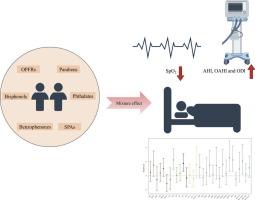中国南方儿童EDCs与阻塞性睡眠呼吸暂停的关系
IF 9.7
1区 环境科学与生态学
Q1 ENVIRONMENTAL SCIENCES
引用次数: 0
摘要
儿童阻塞性睡眠呼吸暂停(OSA)是一种常见的儿童睡眠障碍,其特征是反复出现与睡眠相关的上呼吸道功能障碍。中国是全球OSA患者最多的国家(1.76亿)。环境内分泌干扰物(EDCs)对儿童阻塞性睡眠呼吸暂停的威胁尚不清楚。我们研究了34种EDCs与中国南方儿童OSA的关系。我们从深圳一家三级睡眠诊所招募334名年龄 ≤ 15 岁的儿童(2022年7月- 9月)。采用HPLC-MS/MS对7种有机磷阻燃剂(OPFRs)、3种对羟基苯甲酸酯(parabens)、10种邻苯二甲酸酯代谢物(PAEs)、4种二苯甲酮类(bp)、7种合成酚类抗氧化剂(SPAs)和3种双酚类进行了定量。多变量线性回归评估了与多导睡眠图衍生指数的单化学关联:呼吸暂停低通气指数(AHI)、阻塞性AHI (OAHI)、氧去饱和指数(ODI)和血氧饱和度(SpO2)水平。通过基于分位数的g计算(Qgcomp)评估混合效应。多种EDCs与AHI、OAHI和ODI呈显著的剂量反应关系(p <; 0.05),而与SpO2呈负相关。Qgcomp显示,EDC混合物浓度每增加一分位数,AHI[18.53 %(95 % CI: 6.18 ~ 32.31)]、OAHI[23.27 %(13.88 ~ 34.99)]和ODI[15.03 %(5.13 ~ 24.61)]升高,基线SpO2[-0.25(- 0.49 ~ - 0.01)]、最低SpO2[-1.09(- 2.17 ~ - 0.01)]和平均SpO2[-0.39(- 0.70 ~ - 0.07)]降低,DBP对AHI、OAHI和ODI的负面影响最大,BCIPP对基线和平均SpO2的积极影响最大。这项首次生物监测研究表明,EDC混合物,特别是邻苯二甲酸盐和OPFRs,与儿童OSA发病机制有关。我们的研究结果强调了化学政策改革和纵向调查的必要性,以阐明环境暴露与睡眠呼吸障碍之间的生物学机制。本文章由计算机程序翻译,如有差异,请以英文原文为准。

Hallmarks of EDCs among children in Southern China in Relation with obstructive sleep apnea
Childhood obstructive sleep apnea (OSA) is a common pediatric sleep disorder characterized by recurrent sleep-related upper airway dysfunction. China has the highest number of OSA sufferers (176 million) globally. Environmental endocrine-disrupting chemicals (EDCs) posed unrecognized threats to pediatric OSA are not clear. We examined the associations of 34 kinds of EDCs with childhood OSA in Southern China. We recruited 334 children aged ≤ 15 years (July-September 2022) from a tertiary sleep clinic in Shenzhen. Using HPLC-MS/MS, we quantified 7 organophosphate flame retardants (OPFRs), 3 parabens, 10 phthalate metabolites (PAEs), 4 benzophenones (BPs), 7 synthetic phenolic antioxidants (SPAs), and 3 bisphenols. Multivariable linear regression evaluated single-chemical associations with polysomnography-derived indices: apnea-hypopnea index (AHI), obstructive AHI (OAHI), oxygen desaturation index (ODI), and blood oxygen saturation (SpO2) levels. Mixture effects were assessed through quantile-based g-computation (Qgcomp). Multiple EDCs demonstrated significant dose–response relationships with AHI, OAHI, and ODI (p < 0.05), while inversely associated with SpO2. Qgcomp revealed each tertile increase in EDC mixture concentration corresponded to elevated AHI [18.53 % (95 % CI: 6.18 to 32.31)], OAHI [23.27 % (13.88 to 34.99)], and ODI [15.03 % (5.13 to 24.61)], along with decreased baseline SpO2 [-0.25 (−0.49 to −0.01)], lowest SpO2 [-1.09 (−2.17 to −0.01)], and mean SpO2 [-0.39 (−0.70 to −0.07)], with DBP exhibiting the strongest negative effects on AHI, OAHI, and ODI, and BCIPP showing the greatest positive effects on baseline and mean SpO2. This first biomonitoring study implicates EDC mixtures, particularly phthalates and OPFRs, in pediatric OSA pathogenesis. Our findings underscore the need for chemical policy reforms and longitudinal investigations elucidating biological mechanisms linking environmental exposures to sleep-disordered breathing.
求助全文
通过发布文献求助,成功后即可免费获取论文全文。
去求助
来源期刊

Environment International
环境科学-环境科学
CiteScore
21.90
自引率
3.40%
发文量
734
审稿时长
2.8 months
期刊介绍:
Environmental Health publishes manuscripts focusing on critical aspects of environmental and occupational medicine, including studies in toxicology and epidemiology, to illuminate the human health implications of exposure to environmental hazards. The journal adopts an open-access model and practices open peer review.
It caters to scientists and practitioners across all environmental science domains, directly or indirectly impacting human health and well-being. With a commitment to enhancing the prevention of environmentally-related health risks, Environmental Health serves as a public health journal for the community and scientists engaged in matters of public health significance concerning the environment.
 求助内容:
求助内容: 应助结果提醒方式:
应助结果提醒方式:


